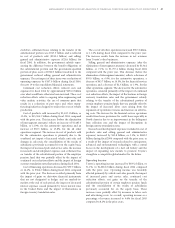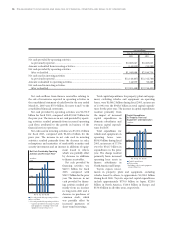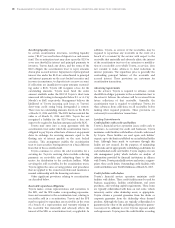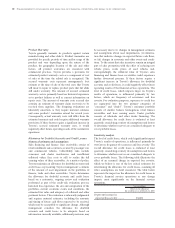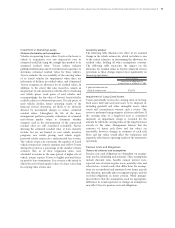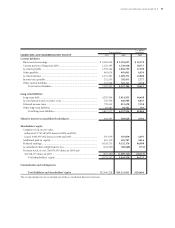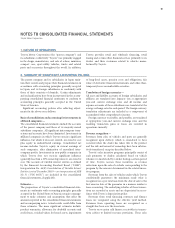Toyota 2005 Annual Report Download - page 73
Download and view the complete annual report
Please find page 73 of the 2005 Toyota annual report below. You can navigate through the pages in the report by either clicking on the pages listed below, or by using the keyword search tool below to find specific information within the annual report.
MANAGEMENT’S DISCUSSION AND ANALYSIS OF FINANCIAL CONDITION AND RESULTS OF OPERATIONS >71
adopt the Standard at the beginning of its next fiscal year,
instead of the next reporting period, that begins after June
15, 2005. Management does not expect this statement to
have a material impact on Toyota’s consolidated financial
statements.
In December 2004, FASB issued FAS No. 153, Ex-
changes of Nonmonetary Assets—an amendment of APB
Opinion No. 29 (“FAS 153”). The guidance in APB
Opinion No. 29, Accounting for Nonmonetary Transac-
tions, is based on the principle that exchanges of
nonmonetary assets should be measured based on the fair
value of the assets exchanged. The guidance in that
Opinion; however, included certain exceptions to that
principle. FAS 153 amends Opinion No. 29 to eliminate
the exception for nonmonetary exchanges of similar
productive assets and replaces it with a general exception
for exchanges of nonmonetary assets that do not have
commercial substance. A nonmonetary exchange has
commercial substance if the future cash flows of the entity
are expected to change significantly as a result of the
exchange. FAS 153 is effective for nonmonetary asset
exchanges occurring in fiscal periods beginning after June
15, 2005. Management does not expect this statement to
have a material impact on Toyota’s consolidated financial
statements.
In March 2005, FASB issued the FASB Interpretation
No. 47, Accounting for Conditional Asset Retirement
Obligations—an interpretation of FASB Statement No.
143 (“FIN 47”). This Interpretation clarifies that the term
conditional asset retirement obligation as used in FASB
Statement No. 143, Accounting for Asset Retirement
Obligations, refers to a legal obligation to perform an asset
retirement activity in which the timing and (or) method of
settlement are conditional on a future event that may or
may not be within the control of the entity. FIN 47
requires a company to recognize a liability for the fair
value of a conditional asset retirement obligation if the fair
value of the liability can be reasonably estimated. The fair
value of a liability for the conditional asset retirement
obligation should be recognized when incurred. FIN 47 is
effective no later than the end of fiscal years ending after
December 15, 2005. Management does not expect this
statement to have a material impact on Toyota’s con-
solidated financial statements.
In May 2005, FASB issued FAS No. 154, Accounting
Changes and Error Corrections—a replacement of APB
No. 20 and FAS No. 3 (“FAS 154”). FAS 154 replaces APB
Opinion No. 20, Accounting Changes, and FASB State-
ment No. 3, Reporting Accounting Changes in Interim
Financial Statements, and changes the requirements for
the accounting for and reporting of a change in
accounting principle. FAS 154 applies to all voluntary
changes in accounting principle. It also applies to changes
required by an accounting pronouncement when the
pronouncement does not include specific transition
provisions. APB Opinion 20 previously required that most
voluntary changes in accounting principle be recognized
by including in net income of the period of the change the
cumulative effect of changing to the new accounting
principle. FAS 154 requires retrospective application to
prior periods’ financial statements of changes in
accounting principle. FAS 154 is effective for accounting
changes and corrections of errors made in fiscal years
beginning after December 15, 2005. The impact of
applying FAS 154 will depend on the change, if any, that
Toyota may identify and record in future period.
CRITICAL ACCOUNTING ESTIMATES
The consolidated financial statements of Toyota are
prepared in conformity with accounting principles generally
accepted in the United States of America. The preparation
of these financial statements requires the use of estimates,
judgments and assumptions that affect the reported
amounts of assets and liabilities at the date of the financial
statements and the reported amounts of revenues and
expenses during the periods presented. Toyota believes
that of its significant accounting policies, the following
may involve a higher degree of judgments, estimates and
complexity:


